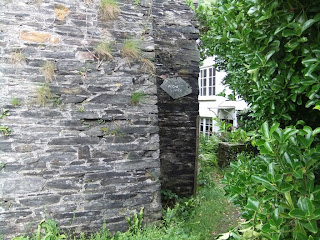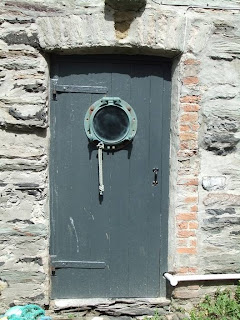All over town we’ve noticed the importance of doorways,
gateways, and entrances to keep things organized, to tell us where to go and where not to go, what
spaces are and are not to be used for,
or what they used to be used for, or
what they might have been or still are used for. There are doorways to
homes, of course, but also entrances that direct people into streets. There are exit doors to let rescue boats out
of garages, and slipways to get them into the harbor in a hurry. There are the breakwaters that form the
entrance to the harbor, or to the sea, depending on your purpose. There are
doorways to let the fish catch into the fish cellars so they can be cleaned
and/or salted down and cured. On the
other end of the building is the entrance to direct people in to buy the
fish. There are landlocked doorways with
inexplicable boat portals installed, until we learn that the ocean broke
against that door for 200 years, before the breakwaters were built, so perhaps
a round portal was a good idea, not a vanity.
There is the flowered path that barely admits entrance to
the Coastal Path, and the less intimidating flowered path up to a stately
home. There is the darkly ominous, (or
promising, if you’re a pirate), opening to a cave in Port Gaverne harbor (or
any number of similar caves up and down the coast). They drip and gleam, lined with shellfish the
size of a British Pound, waiting for the ocean to wash up to their stoops again
at high tide. And there are dark,
neglected stone arches on derelict old buildings that we can only guess at:
perhaps a lime kiln? Something
else? Speaking of darkly ominous, there
is the doorway to the old school, now a bar, restaurant, and hotel. Hooray for adaptive re-use! There are some that are frankly confusing,
such as “Pilchards Corner” sign on the wall.
It’s unlikely any pilchards could read the sign. On the other hand, few pilchard shoals come
to call at the ports anymore. Perhaps it
was the people of the village who couldn’t read the writing on the wall, as the
shoals dwindled from overfishing.
 |
| Pilchards Corner |
 |
| The Pirates Cave |
In the end, Port Isaac is less a network of paths and more an
intricate system of entrances and exits.
Only a few steps in any direction yields a myriad of opening and
doorways, some of which are meant for you, and some of which are emphatically
not. Deciphering them at the walk is amusing.
Doing so at driving speed is best left to the natives. It is no wonder that Napoleon, frustrated in
his inability to understand the narrow nooks and crannies of Paris, blasted
great avenues across the city. We
celebrate those great avenues today, but duck out of them at the first
opportunity, to explore the little corners created when people built their towns
an inch at a time. Down near the harbor,
Port Isaac is still this complex, intense space. Outsiders come here just to
wander around in it. It alters their
view of the world, for a little while.
It is strangely delightful to be in a place that is organized in a way
that we, as foreigners, don’t quite yet understand. It’s like working out a crossword puzzle, one
entryway at a time.
















No comments:
Post a Comment